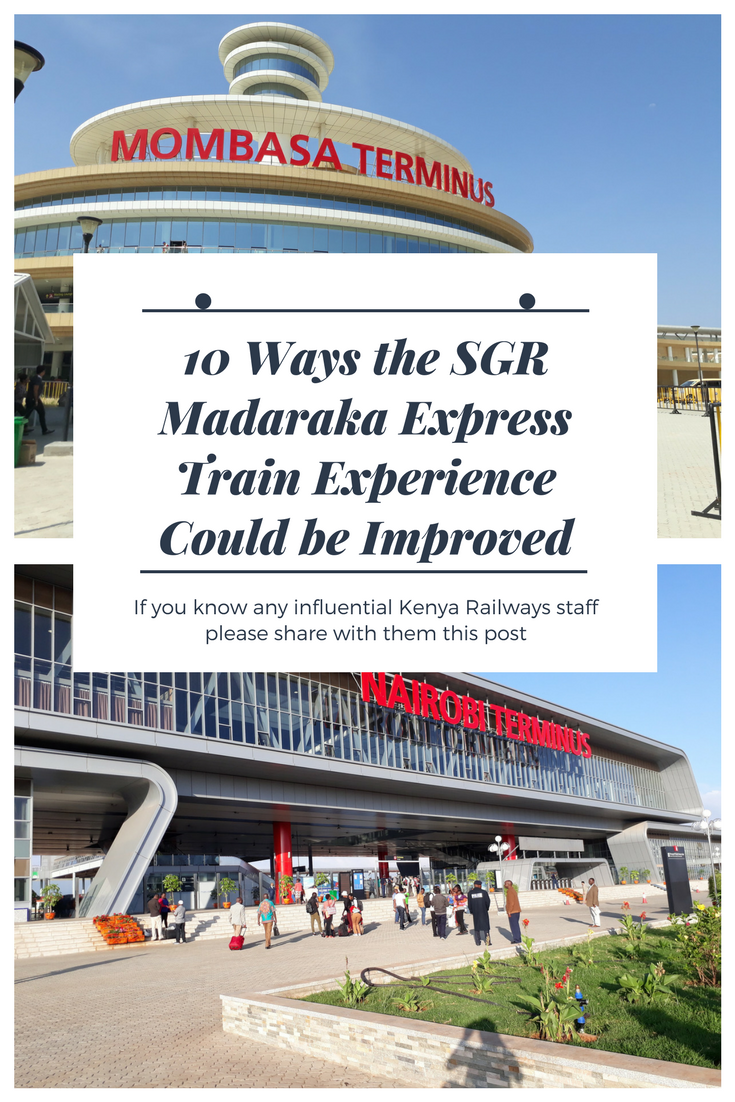The Madaraka Express SGR train services between Nairobi and Mombasa finally saw the light of day after an almost 5 year wait.
We can now officially say that the Standard Gauge Railway (SGR) Project in Kenya is over.
And that the long-awaited Madaraka Express SGR trains now ply the Nairobi Mombasa route daily in a record 4.5 hours. Instead of the previous 15 hours by the Lunatic Express of yester years.

When construction of the first Meter Gauge Rail (MGR) network in Kenya – commonly referred to as ‘
So in 1903, operations commenced on the line.
But fast forward to 114 years later, and the Standard Gauge Railway (SGR) saw the light of day.
If you are fortunate to have traveled on both the MGR and SGR, you will appreciate the difference in the two.
Even just between their terminals.


But that doesn’t mean that there isn’t room for further improvements on the SGR.
“Change can be frightening, and the temptation is often to resist it. But change almost always provides opportunities – to learn new things, to rethink tired processes, and to improve the way we work.” ~Klaus Schwab
On the train, I noticed that there were feedback forms put in a train somewhere at the end of the coaches.
I filled one but I am not sure if anyone ever looks at them.
So if you or anyone you know works at SGR and would do with some feedback, please share with them this post.
Here are 6 improvements that if made would make the SGR experience a little more fun and comfortable for its passengers:
- Enable end – to – end SGR train ticket booking, payment, and printing of ticket. As it is right now, you can only book your SGR ticket online. However, payment is either by M-PESA or over the counter at the SGR termini. Tickets can only be printed at the train stations. An improvement would be to enable credit/debit card payments as well as the ability to download your ticket on the phone and/or print it by oneself.
- Provide a seat map on the online booking portal to enable passengers to select their seat preferences and coaches. Currently, the system automatically assigns seats. This can especially be stressful for those families traveling with small kids who find themselves assigned seats randomly and with strangers. This still happens even though the system assigns seats that follow each other.
- Allow passengers to check in to their coaches/seats as they arrive and complete security clearance. The current practice is that everyone has to wait for everyone else before they are all hurled together to board the train like a herd of goats through one set of very narrow escalators and another one set of narrow stair case at the last minute.
- Charging ports for mobile phones in the coaches will go a long long way.
- We would very much appreciate free Wi-Fi in the train. Do I really need to elaborate on this one? The next point is a very sensitive one and please forgive me if I step on anyone’s toes. It is not my intention whatsoever. I will however try to present it in the most respectful way possible.
- Install both western-style toilets and washlet-style toilet seats or squat toilets with bidet showers or health faucets.Anyone who has been to a largely Muslim dominated region will notice two things: there will always be a prayer room, and the bathroom facilities are fitted with bidet showers – its a ‘horse pipe’ like facility. The SGR trains have neither of this and yet its routes are from Nairobi and Coast province that is largely Muslim. Where am I headed to with this… it was quite inconveniencing for passengers wanting to use the bathrooms as they were constantly flooded with water, and plastic bottles as other passengers who prefer using water rather than other methods of cleansing e.g. toilet paper after defecation or urination, struggled to be innovative … In case you’re still lost, this is what I’m talking about:
 Taking demographics such as prevailing culture and religion into perspective is one of the first steps towards customer service. Moving on. Still on toilets…
Taking demographics such as prevailing culture and religion into perspective is one of the first steps towards customer service. Moving on. Still on toilets… - Install more toilets at the Nairobi Railway Station. It is very hard to believe that this station has a total of 2 toilets for ladies and another 2 for the men to cater for thousand of commuters.
- Segment the SGR coaches into quiet zones and non-quite zones to take care of different customer needs. I believe this is one way of helping deal with the noise. On the Mombasa bound train, it was a grueling 6 hours to deal with a bunch of about 10 male commuters who chose to convert the train into a morning village baraza and they were talking at the top of their voices in their vernacular. Sad that I couldn’t even eavesdrop… sigh! On the way back, it was another 6 hours of dealing with babies and children who took turns at throwing tantrums and screaming at the top of their voice.
- Inform passengers of the Railways CBD Bound Train departure time just before arrival at the terminus. It would help to announce the commuter train schedule, a few minutes before the train arrives Nairobi Terminus. On this trip, there was a man with a horn like speaker at the very end of the escalator trying to direct commuters to the CBD bound train. And this was like 3 minutes to the train’s doors closing. It was sad to see some passengers miss the commuter train that connects the Nairobi Terminus and Nairobi Terminus by a whisker. Some of them were older women, while others had such heavy luggage so they couldn’t meddle through the crowd as fast.
Yeah, I know I said there was 10 ways. Have you travelled on the SGR Train? What are some ways you think the SGR could improve? Share with us your suggestions in the comments below. You never know who could stumble on this post and actually implement the suggestions.



